The Google Nexus 7 Review
by Anand Lal Shimpi & Brian Klug on July 26, 2012 11:35 AM ESTThe Display
In this new age of high resolution panels with small dimensions, the goal seems to be to just get the display out of the way. You shouldn't notice the display, it should just quietly do its job and make you believe that what you're looking at is real. When viewed with this critical eye, very few displays do their job well.
The Nexus 7's display is somewhere between good and perfection. It's not on the latter end of the spectrum, but it's great for $199. Black levels are good, and max brightness is more than enough for indoor use, although you'll have problems outdoors if it's too sunny.
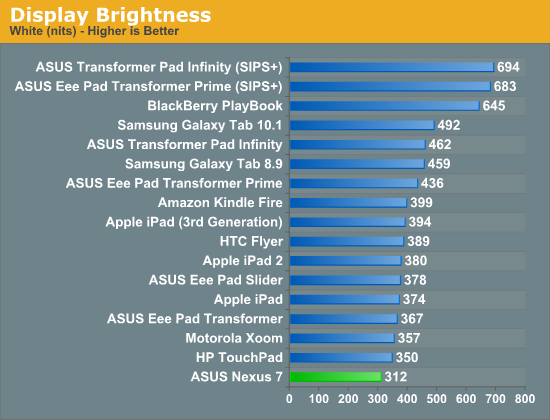
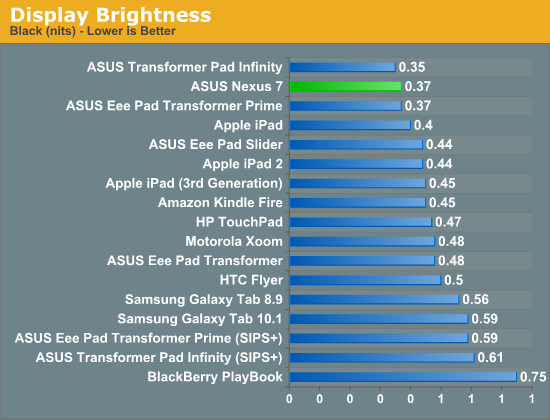

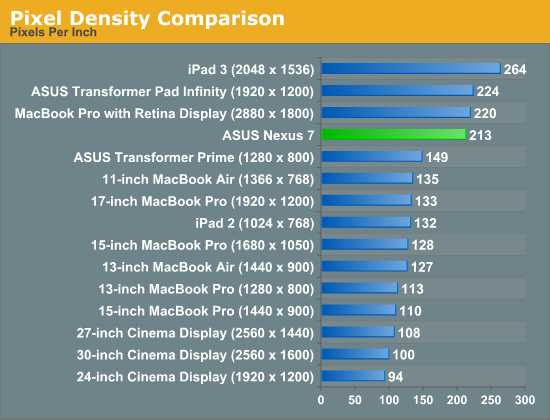
The resolution is high enough that neither Brian nor I were able to identify individual pixels at our normal viewing distances. Images do look better on the new iPad however (not a resolution but rather a panel advantage).
The other interesting aspect of the Nexus 7 is that it is a relatively new and somewhat interesting display form factor. 213 pixels per inch in a 7 inch display is unique for an Android tablet, and puts the Nexus 7 in the "tvdpi" screen density category for Android, 600 x 961 dp (that's dp - density independent pixels, relative to 160 ppi).
The end result is that some applications get a scaled down version of the 10" form factor Android 4.x UI, others don't. Some pages use the phone layout (for example the settings page, play store, and the notifications shade), others use the tablet two pane layout (for example Gmail) due to the 600dp width of the Nexus 7. That is to say it isn't totally correct to say that the UI on the Nexus 7 is a larger, scaled version of the phone UI, but something of an intermediary between the traditional 10" tablet version, and the phone version depending on what the break point is (in dps) for the particular app.
The other interesting note is that because 'tvdpi' isn't a primary display density for Android developers to build assets against, most often bitmaps get scaled down from the hdpi asset. In most places there isn't much of a noticeable softening of the edges, but I'll admit there are a few places where it's obvious bitmaps have been decimated and look a bit soft. Luckily, the pixel density of the display itself is high enough to mask most of this, but it isn't always perfect.
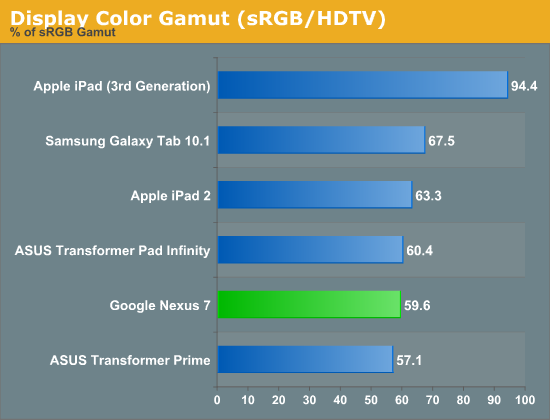
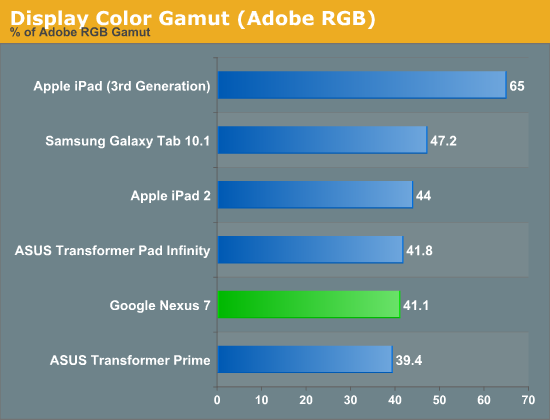
The Nexus 7's IPS panel offers great viewing angles, something that's simply a requirement for any device whose primary interface revolves around the display. Color accuracy is simply middle of the road, but I don't expect many users to do a lot of professional photo editing on the Nexus 7 so I'm not sure how much this actually matters.


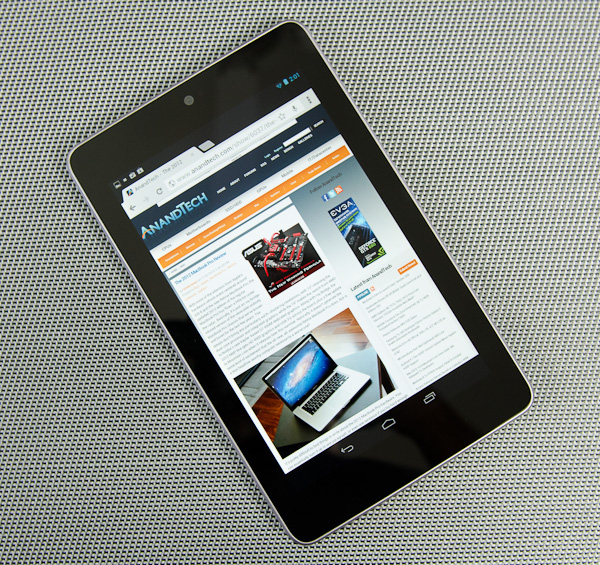








118 Comments
View All Comments
chrnochime - Thursday, July 26, 2012 - link
Great product for those who don't mind reading on a 7" screen, but for me even the 10" gets tiring after a while, though considerably less so than a 7".I am amazed at those who are able to read the tiny texts on a 7" for a prolonged period of time. Tried that with a 10" and couldn't last more than 1hr. Uh.
amdwilliam1985 - Thursday, July 26, 2012 - link
Tell that to the girls who are reading on iPhone with 3.5", I can barely see the tiny texts on their screen.Going from 3.5" to 7" will 4x their reading area, will make a heavenly difference for them.
jamyryals - Thursday, July 26, 2012 - link
What does being a girl have to do with it? I read books on my 4s quite often when traveling. Last time I checked I was a man... Yup, still am.amdwilliam1985 - Friday, July 27, 2012 - link
Sorry to bring girls into the topic.I'm only saying that because I see a lot of girls in NYC subways with iPhone 4/4S. Most guys I saw in NYC subways are with bigger phones. Just reporting my observation.
And the point of the topic is that if people can read on 3.5", then reading on 7" will be a dramatic(4x) improvement.
Akilaehunter - Thursday, July 26, 2012 - link
Every buy a paperback with uncomfortably small lettering? Or even a hardcover that tries to look artsy by using an inconvenient font?All (worthwhile) e-readers and e-reader apps allow for margin size, text size, and font style changes.
Argument is invalid; You can read a book on a 4" screen as optically comfortably as on a 10" screen, you'll just wear out your fingers flipping resized pages.
chrnochime - Thursday, July 26, 2012 - link
It's not invalid; I'd rather not have to enlarge everything and scroll a whole bunch just to read one 8" x 11" webpage.Yes I can actually see the texts all shrunken on a 7", but I have no intention to torture myself in doing so. Rather spend that time on something more productive.
Besides I *did* say it's a great device didn't I?
And not all e-readers are stuck in 7". The Amazon DX is 10" which I also have, so.
Akilaehunter - Friday, July 27, 2012 - link
Webpages, you're 100% right. I don't own a 10" tablet and even in landscape mode on a 7" many webpages can get uncomfortably small. Plus the scrolling.Still, if the nook/kindle app is uncomfortable to read books with it's one's own fault for not making it comfortable with the many combinations of size options.
CeriseCogburn - Sunday, July 29, 2012 - link
It's never comfortable as the screen needs to be closer so the eye fry syndrome overtakes any blurry eyed goon who can't read small text.I suspect a far sighted elderly person with bifocals can hold it at arms length and "telescope" in to the text, but then, have never seen that.
Next we'll have a flurry of articles analyzing peeps with facial skin cancer then we'll have the scare articles that quote the hidden study.
In the mean time the tiny teens and teeny texts can increase corporate visine profit margins.
They should call these devices "fryballs!"
Super56K - Monday, July 30, 2012 - link
Yes, because before e-readers/tablets all the books I purchased were 10" + in physical size, and I had to hold mass market paperbacks 5" away from my face to read the tiny words. You're a feisty one Cogburn.Akilaehunter - Thursday, July 26, 2012 - link
First off, this is my first article response, though I've been lurking since 2004.A nitpick to start things off: I know this site tests a ton of mobile hardware so why are some models shown for some tests in an article and not others -in the same article- as comparisons? For instance, my Droid Razr Maxx is in a few comparisons (not this article) but not all. Should maybe be a database cataloguing them all, ala the gfx card benches section? (Or if there is I'm too dense to see it...)
Otherwise, excellent article as always. Especially interested in how the flash storage is the main bottleneck now. Tegra 3 could be a beast at multitasking if all its cores are accounted for, but would then get strangled by IO as soon as it is told to multitask- something a multi-core cpu should be amazing at.
Lot to think about. :D